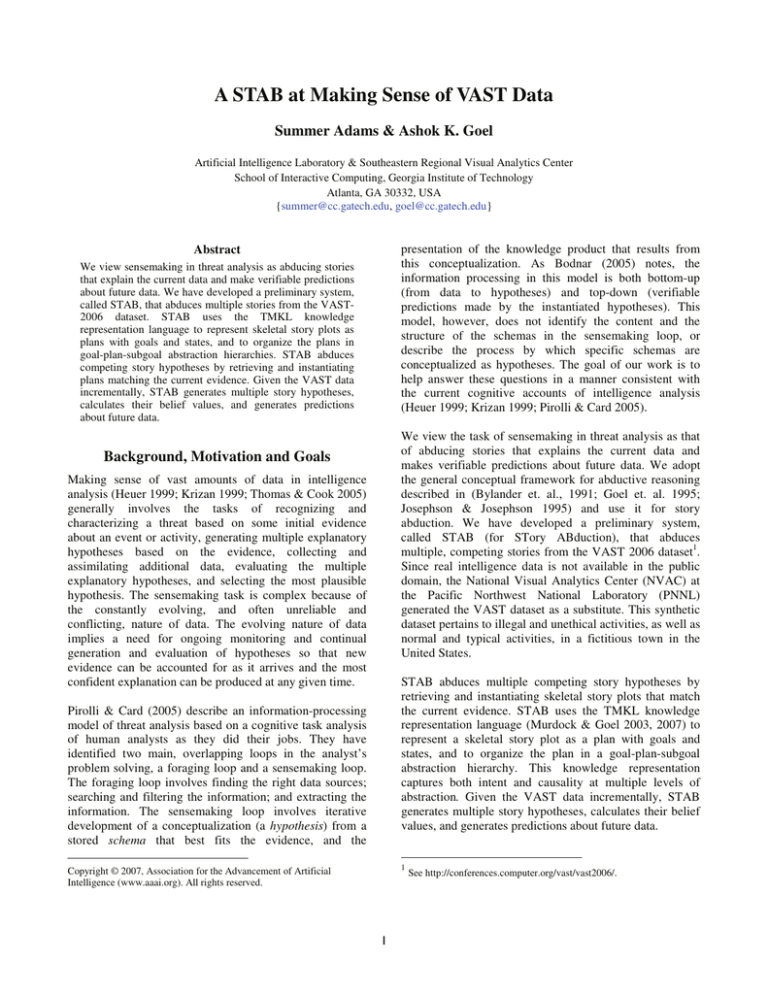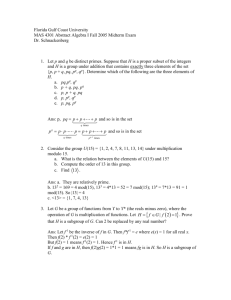
A STAB at Making Sense of VAST Data
Summer Adams & Ashok K. Goel
Artificial Intelligence Laboratory & Southeastern Regional Visual Analytics Center
School of Interactive Computing, Georgia Institute of Technology
Atlanta, GA 30332, USA
{summer@cc.gatech.edu, goel@cc.gatech.edu}
presentation of the knowledge product that results from
this conceptualization. As Bodnar (2005) notes, the
information processing in this model is both bottom-up
(from data to hypotheses) and top-down (verifiable
predictions made by the instantiated hypotheses). This
model, however, does not identify the content and the
structure of the schemas in the sensemaking loop, or
describe the process by which specific schemas are
conceptualized as hypotheses. The goal of our work is to
help answer these questions in a manner consistent with
the current cognitive accounts of intelligence analysis
(Heuer 1999; Krizan 1999; Pirolli & Card 2005).
Abstract
We view sensemaking in threat analysis as abducing stories
that explain the current data and make verifiable predictions
about future data. We have developed a preliminary system,
called STAB, that abduces multiple stories from the VAST2006 dataset. STAB uses the TMKL knowledge
representation language to represent skeletal story plots as
plans with goals and states, and to organize the plans in
goal-plan-subgoal abstraction hierarchies. STAB abduces
competing story hypotheses by retrieving and instantiating
plans matching the current evidence. Given the VAST data
incrementally, STAB generates multiple story hypotheses,
calculates their belief values, and generates predictions
about future data.
We view the task of sensemaking in threat analysis as that
of abducing stories that explains the current data and
makes verifiable predictions about future data. We adopt
the general conceptual framework for abductive reasoning
described in (Bylander et. al., 1991; Goel et. al. 1995;
Josephson & Josephson 1995) and use it for story
abduction. We have developed a preliminary system,
called STAB (for STory ABduction), that abduces
multiple, competing stories from the VAST 2006 dataset1.
Since real intelligence data is not available in the public
domain, the National Visual Analytics Center (NVAC) at
the Pacific Northwest National Laboratory (PNNL)
generated the VAST dataset as a substitute. This synthetic
dataset pertains to illegal and unethical activities, as well as
normal and typical activities, in a fictitious town in the
United States.
Background, Motivation and Goals
Making sense of vast amounts of data in intelligence
analysis (Heuer 1999; Krizan 1999; Thomas & Cook 2005)
generally involves the tasks of recognizing and
characterizing a threat based on some initial evidence
about an event or activity, generating multiple explanatory
hypotheses based on the evidence, collecting and
assimilating additional data, evaluating the multiple
explanatory hypotheses, and selecting the most plausible
hypothesis. The sensemaking task is complex because of
the constantly evolving, and often unreliable and
conflicting, nature of data. The evolving nature of data
implies a need for ongoing monitoring and continual
generation and evaluation of hypotheses so that new
evidence can be accounted for as it arrives and the most
confident explanation can be produced at any given time.
STAB abduces multiple competing story hypotheses by
retrieving and instantiating skeletal story plots that match
the current evidence. STAB uses the TMKL knowledge
representation language (Murdock & Goel 2003, 2007) to
represent a skeletal story plot as a plan with goals and
states, and to organize the plan in a goal-plan-subgoal
abstraction hierarchy. This knowledge representation
captures both intent and causality at multiple levels of
abstraction. Given the VAST data incrementally, STAB
generates multiple story hypotheses, calculates their belief
values, and generates predictions about future data.
Pirolli & Card (2005) describe an information-processing
model of threat analysis based on a cognitive task analysis
of human analysts as they did their jobs. They have
identified two main, overlapping loops in the analyst’s
problem solving, a foraging loop and a sensemaking loop.
The foraging loop involves finding the right data sources;
searching and filtering the information; and extracting the
information. The sensemaking loop involves iterative
development of a conceptualization (a hypothesis) from a
stored schema that best fits the evidence, and the
1
Copyright © 2007, Association for the Advancement of Artificial
Intelligence (www.aaai.org). All rights reserved.
1
See http://conferences.computer.org/vast/vast2006/.
We view STAB as an automated assistant that may act as
an external memory for human analysts. The external
memory may support threat analysis by (a) focusing the
attention of the analyst on specific hypotheses, and (b)
keeping track of multiple, competing hypotheses.
Injected-mouse(Boynton-Labs prion-disease)
Injected-cow(Boynton-Labs prion-disease)
treatment-mouse(Boynton-Labs prion-disease)
treatment-cow(Boynton-Labs prion-disease)
TABLE 2
KNOWLEDGE STATE PRODUCED BY
THE SAMPLE INPUT EVENTS
Actions
Resulting State
Stolen
Has-object
Broken
Is-broken
Cured-disease
Is-rich-and-famous
Named-after
Expert-involved
Was-founded
Is-open
Have-developed
Exists-new-disease
Announced-investigation
Is-investigating
Discontinued-investigation
Cancel-investigation
Injected-cow
Cow-is-infected
Treatment-cow
Cow-is-cured
A Model of the VAST Dataset
We begin with an introduction to the VAST-2006 dataset.
The VAST dataset contains over a thousand news stories
written in English, and a score of tables, maps and
photographs. Figure 1 shows an example news story from
the VAST dataset. We analyzed this dataset and screened
the stories that indicated an illegal or unethical activity,
which left about a hundred news stories out of the more
than a thousand originally in the dataset. We then analyzed
the remaining stories and manually extracted all the events
that pertained to illegal/unethical activities; Table 1 shows
a sample of such events that form the input to STAB. We
also hand crafted representations for each of these events
in terms of the knowledge states it produces; Table 2
shows the representations for a sample of events input to
STAB. In addition, we examined the maps, photos and
tables that are part of the VAST dataset and similarly
extracted and represented the relevant input information.
Abductive Reasoning, Plan Recognition, and
Story Understanding
Abduction is generally characterized as inference to the
best explanation for a given set of data. The general task of
abduction takes as input a set of data, and has the goal of
giving as output the best explanation for the dataset.
Abductive reasoning includes generation, criticism and
possible acceptance of candidate explanatory hypotheses.
Factors that make one explanation better than another
include explanatory coverage, plausibility, and, in case of
composite explanations, internal consistency and
parsimony. AI research has led to a number of
computational models of abduction starting with Pople’s
(1977) early work on medical diagnosis. These models
range from normative models based on minimal set
covering algorithms, e.g., (Reggia, Nau & Wang, 1983),
logical reasoning from first principles, e.g., (Reiter 1987),
and probabilistic inference in Bayesian networks, e.g.,
(Pearl 1987); to functional models based on task
decomposition, e.g., (Josephson & Josephson 1994).
Figure 1. Example news story from the VAST dataset.
TABLE 1
SAMPLE INPUTS FOR STAB
Sample STAB Inputs
stolen(money $40 Highway-Tire-Store)
cured-disease(Boynton-Labs
Philip-Boynton
priondisease)
named-after(lab Philip-Boynton Dean-USC)
was-founded(Boynton-Labs)
have-developed(Boynton-Labs prion-disease)
announced-investigation(USFDA Boynton-Labs)
discontinued-investigation(USFDA Boynton-Labs)
The input to the abduction task in threat analysis is
characterized by the following features (e.g., the VAST
dataset):
• The amount of data is huge.
• Data comes from multiple sources and in multiple
forms.
• Data from various sources may be unreliable and
conflicting.
• Data arrives incrementally and is constantly
evolving.
2
•
•
•
•
III. The composite explanation is parsimonious, i.e.,
no proper subset of the composite explanation can
explain as much of the data.
IV. The composite explanation is a confident
explanation; an explanation is confident if its
belief value is significantly higher than that of
alternative explanations.
Data may pertain to multiple actors, where the
actions of the various actors need not be
coordinated.
The actors may try to hide data about their
actions, and may even introduce spurious data to
hide their actions.
Data may pertain to novel actors as well rare
actions.
The amount of useful evidence is a small fraction
of the vast amount of data (the proverbial “needle
in the haystack” problem).
Plan Recognition: Schmidt, Sridharan & Goodson (1978)
identified plan recognition as an AI problem, and proposed
a hypothesize-revise mechanism for addressing it. Cohen,
Perrault & Allen (1982) distinguished between two kinds
of plan recognition situations: keyhole, in which the
observed actor acts as if unobserved, and intended, in
which the observed actor performs actions to aid in the
plan recognition. In threat analysis, we can distinguish
additional types of plan recognition situations: covert, in
which the observed actor tries to hide its actions, and
multiple actor, in which the observed data contains actions
of multiple actors. In multiple actor plan recognition, while
the actions of some actors may be coordinated towards a
shared goal, other actors may have their own independent
goals. Further, the evidence of the actions of various actors
in general is partially-ordered and interleaved.
The desired output of the abduction task in threat analysis
include the following:
• Explanations that causally relate specific
sequences of actions into plans and stories. Since
the data pertains to actions of multiple,
uncoordinated actors, the output may contain
multiple unconnected stories.
• Explanations that specify intent of the various
actors in the stories. Ideally, the intent should be
specified for specific subsequences of actions in
addition to complete sequences.
• Belief values for the explanations that can help
focus and prioritize subsequent processing of
data.
• Explanations that can make verifiable predictions.
Charniak & McDermott (1985) identified plan recognition
as an instance of the general abduction task. As with
abduction, AI research since then has led to several
normative models of plan recognition, including minimal
set covering algorithms and logical reasoning from first
principles, e.g., (Kautz 1991), and probabilistic inference
in Bayesian networks, e.g. (Charniak & Goldman 1993).
More recently, Goldman, Geib & Miller (1999) describe a
model that also takes causal requirements of plan execution
into account.
Given the structure and complexity of the abduction task in
threat analysis, we have adopted the general functional
model of abductive reasoning described in (Bylander et.
al., 1991; Goel et. al. 1995; Josephson & Josephson 1994).
This functional mechanism for abduction has previously
been used in a number of domains, such as medical data
interpretation and diagnosis, scientific theory formation,
speech recognition, and diagram interpretation (Josephson
& Josephson 1994). This model characterizes the best
composite explanation for a set of data based on three
criteria (Bylander et. al, 1991 and Goel et. al (1995)
provide more formal specification):
1. Coverage: One composite explanation is better
than another if explains more of the observed
data.
2. Belief: One composite explanation is better than
another if it has a higher belief value.
3. Parsimony: One composite explanation is better
than another if it is a subset of the other.
The model then characterizes the abduction task as finding
a composite explanation for the given set of data such that
it satisfies four conditions:
I. The composite explanation explains as much of
the observed data as possible in the available
time.
II. The composite explanation is internally
consistent.
At present, it is unclear whether or how these normative
models of plan recognition might be used for threat
analysis. For example, plan recognition in threat analysis
takes partially-observed sequences of actions as its input,
and desires a specification of actors’ goals as part of the
output. In contrast, the model of Kautz (1991) requires as
input a fully-observed sequence of actions, and does not
explicitly represent goals. Charniak & Goldman’s (1993)
model requires conditional probability distributions
between atomic events. While these conditional probability
distributions may be available for domains in which large
corpus of historical data is available, or constructed for
domains which can be easily simulated (e.g., interactive
games), it is unclear how we can obtain such conditional
probability distributions for threat analysis.
The VAST dataset, for example, contains many routine
goals, plans and actions, such as purse snatching,
burglaries, and vandalism. For these, we could try to obtain
conditional probability distributions from investigative
3
Figure 2. The content and structure of a plan in STAB.
agencies such as the local police. However, the VAST
dataset also contains plans for removing a political
opponent from an election by digging dirt on the opponent,
and suspicions that a scientific laboratory may have
released mad cow disease bacteria into a community; the
conditional probabilities for such events are harder to find.
Of course, we could handcraft and fine tune the conditional
probabilities in STAB so that we get the right results for
the VAST dataset, but that seems contrived and is unlikely
to generalize. Therefore, at present we use heuristic
methods for plan recognition in STAB, with the hope these
methods will reveal the deep structure of the problem of
threat analysis.
Knowledge Representation
STAB contains a library of generic, skeletal scripts
relevant to the VAST domain. We found that seven major
scripts appear to cover all the illegal/unethical activities in
the VAST dataset. We handcrafted this library of scripts
into STAB. Figure 2 illustrates a simple script in STAB’s
library, which is composed of several smaller scripts. The
main pattern (in the middle of the figure) is to Rob a Store,
which has several steps to it: Go to Store, Break into Store,
Take Money. This pattern has the goal of Have Money,
given the initial state of Not Have Money (top of figure).
Each of the steps in this pattern can (potentially) be done
using multiple methods. For example, the step of Break
into Store can be done by Entering through a Window or
Entering through a Door (bottom of figure). Each of these
methods in turn is a process consisting of multiple steps.
Figure 3 illustrates a more complex pattern of political
conspiracy in which a political figure may get an opponent
out of an electoral race by exposing dirt on him or having
him assassinated.
Story Understanding: From the early work of Charniak
(1977) and Cullingford (1981) to the recent work of
Mueller (2004), there has been substantial research on
story understanding. There also has been significant work
on story generation, e.g., (Meehan 1981). STAB’s task,
however, is neither story understanding nor story
generation. Traditional story understanding programs (such
as SAM (Cullingford 1981)) take one story as input and
give an understanding of that one story as output. Similarly
story generation programs produce one story at a time. In
contrast, STAB takes fragments from multiple news stories
in the VAST dataset as input, and composes interpretations
of the fragments into one or more stories as its output.
The story patterns are represented in the TMKL knowledge
representation language (Murdock & Goel 2003, 2007). A
task in TMKL represents a goal of an agent, and is
specified by the knowledge states it takes as input, the
knowledge states it gives as output, and relations (if any)
between the input and output states. A task may be
accomplished by multiple methods. A method specifies the
decomposition of a task into multiple subtasks as well as
the causal ordering of the subtasks for accomplishing the
task, and is represented as a finite state machine. Thus, the
TMKL representation of a plan pattern captures both intent
and causality at multiple levels of abstraction.
A skeletal story represented as a plan in STAB is like a
script (Schank & Abelson 1976). However, while a script
specifies a sequence of actions, a story in STAB also
specifies the goals of the action (sub-)sequences and the
knowledge state(s) produced by each action. These
knowledge states play an important role in the retrieval of
stories relevant to a given event. Further, the goals of the
action sequences in the stories specify their intent.
4
Figure 3: The plan for a political conspiracy intended to remove an opponent from an electoral race.
Activated nodes are denoted by a thick outline around yellow boxes and with bold text.
Although we originally developed TMKL to capture an
agent’s self-model of its own knowledge, reasoning and
architecture, it has since been used in several other
applications. TIELT (Molineaux & Aha, 2005), an
environment for evaluating learning in computer games,
uses TMKL as its agent description language. The
AHEAD system (Murdock, Aha & Breslow 2003) uses
TMKL for representing hypotheses about asymmetric
threats. In particular, AHEAD uses past cases of such
threats to generate arguments for and against a given
hypothesis. The explicit specification of the goals of
subsequences of actions allows AHEAD to retrieve past
cases relevant to specific subsequences.
Matcher takes one input event at a time and uses its
resulting knowledge state of the event with the task nodes
in the TMKL representations of the scripts stored in the
Story Library. The Story Matcher tags the matching tasks
and passes the matching plans to a Working Memory.
Then, the Story Matcher inspects the next input event in
the Evidence File and repeats the above process.
If the new input event results in the retrieval of a new
script, then the corresponding plan is similarly stored in the
Working Memory. If the newly retrieved plan is already in
the Working Memory, then additional task nodes that
match the new input are also tagged but only one plan
instance is kept.
TMKL is more expressive than Hierarchical Task
Networks (HTNs) (Erol, Hendler & Nau 1994), but HTN’s
implicitly provide support for features explicitly
represented in TMKL. In a recent experiment, Hoang, LeeUrban & Munoz-Avila (2005) encoded the same gameplaying agent in both TMKL and HTN. They found that
“TMKL provides constructs for looping, conditional
execution, assignment functions with return values, and
other features not found in HTN.” They also found that
since HTN implicitly provides support for the same
features, “translation from TMKL to HTN is always
possible.”
Thus, while TMKL shares the good
computational properties of HTNs, it makes reasoning
easier and more perspicuous.
Figures 5 & 6 illustrate the two script plans, Rob a Store
and Commit Vandalism, respectively, whose task nodes
match the input event Break(Window). The matching task
nodes are shown with a thick outline around yellow boxes
and with bold text. Note that when a leaf task node in a
plan (e.g., Break(Window) in the Rob a Store plot) is
activated, then the higher-level task nodes in the plan that
provide the intentional contexts for the leaf node (Break
into(Store) & Rob(Store)) are also activated.
STAB stores the multiple competing plans (Rob a Store
and Commit Vandalism) in its Working Memory and
assigns belief values to them. The belief value of a plan
hypothesis depends on the proportion of the task nodes in a
plan that are matched by the input evidence (higher the
proportion, higher is the belief value) and the level of
abstraction of the matched task nodes (higher the
abstraction level, more is the weight of the node). Equation
(1) represents the formula for calculating belief values
where level is the depth of the task within the hierarchy of
Computational Process
Figure 4 shows the high-level architecture of STAB. First,
The Evidence Collector collects the input events in an
Evidence File in chronological order. Next, the Story
5
Figure 4: High-Level Architecture of STAB.
the plan and n is the maximum depth of the task hierarchy
for the plan. As an example, the belief value for the
Commit Vandalism plan (Fig. 6) is (100% / 1) + (50% / 2)
= 1.25. Note that only the sub-tree of the method with
activated tasks is used in the belief calculation. Similarly,
the belief value of the Rob a Store before the Take(Money)
node is activated equals 1.33.
(Money), then this node too in the Rob a Store story is
tagged, and Equation 1 is used to update the belief value of
the hypothesis to 1.50. If the new data contains evidence
that contradicts an expectation generated by a hypothesis,
then the hypothesis is considered as refuted, and its belief
value is reduced to 0.
At the end, STAB generates a report which displays all
current plan hypotheses (including refuted hypotheses, if
any), the belief value of each hypothesis, and the evidence
for and against each hypothesis. Since STAB continually
monitors the Evidence File and updates its Working
Memory, the user may at any point query STAB to inspect
the current hypotheses and the related evidence.
n
# activated tasks at level/total tasks at level
(1)
level
level =1
∑
The plan hypotheses in the Working Memory generate
expectations. Thus, the Rob a Store hypothesis generates
expectations about the events Go to (Store), Enter
(Building), and Take (Money), while the Commit
Vandalism hypothesis generates expectation about only
Kick In (Door). As additional data arrives as input in the
Evidence File, STAB matches the data with the
expectations generated by the candidate hypotheses. If, for
example, the new data contains evidence about Take
Evaluation
Evaluation of STAB is challenging for two reasons.
Firstly, since there is little intelligence data available in the
public domain in a suitable form, we cannot directly test
Figure 5: The activated nodes in the Rob a Store plan.
6
expectations generated by a hypothesis but also for
evidence that may contradict the expectations.
STAB provides preliminary, but verifiable, answers to two
questions arising from Pirroli & Card’s model of
sensemaking: what is the content of the schemas, and what
is process for developing a hypothesis? According to
STAB, the schemas are scripts, where the scripts pertain
the activities of interest to an analyst, e.g., illegal/unethical
activities in the VAST domain. The scripts are represented
as plans with goals and states. The TMKL language
provides a scheme for representing intent and causality of
sequences of events at multiple levels of abstraction.
Scripts are retrieved by matching input events with the task
nodes in the script representations. Belief value of a plan
hypothesis depends on the proportion and level of the
matched task nodes. The retrieved stories generate
expectations about data, and the confirmation of these
expectations results in updates to the belief values.
Figure 6: The activated nodes in the Commit Vandalism plan.
STAB. Secondly, given the high cost of an analyst’s time,
evaluating STAB with a human intelligence analyst can be
justified and made possible only after STAB is validated as
a proof of concept system.
Thus, our evaluation of STAB as a proof of concept system
has taken two alternative threads. Firstly, we have
demonstrated STAB to an expert who has done significant
work with intelligence analysts. This expert found STAB’s
knowledge representations and information processing as
“plausible.” However, the expert also raised serious
concerns about the usability of STAB’s preliminary
graphical interface. Secondly, we have begun evaluating
STAB for the new VAST-2007 dataset2 recently released
by PNNL.
As with the VAST-2006 dataset, we
handcrafted representations of events in the VAST-2007
dataset corresponding to illegal/unethical activities. When
these events were given to STAB as input, we found that
STAB invoked six plans (of the seven stored in its library),
three plans with high belief values and the other three with
relatively low belief values. Our preliminary analysis
suggests that STAB thus makes the right plan hypotheses
for the VAST-2007 dataset.
In its present state of development, STAB has many
limitations. Firstly, the input events to STAB are extracted
from new stories and represented by hand. We are building
a mechanism for automatic extraction of input events from
news stories. Secondly, STAB uses a simple, heuristic
method for calculating belief values. We are developing a
more robust method for calculating belief values based on
the principles of coverage and parsimony. Thirdly, STAB
does not propagate the values of variables between the
nodes in a plan pattern. We are augmenting TMKL to
automate variable propagation. Finally, we are conducting
usability tests with STAB’s interface, and constructing a
more usable graphical interface.
Summary, Conclusions, and Future Work
Psychological studies of intelligence analysis (Heuer 1999)
indicate the three main errors made by human analysts in
hypothesis generation: (1) Due to limitations of human
memory, intelligence analysts may have difficulty keeping
track of multiple explanations for a set of data over a long
period of time. (2) Analysts may quickly decide on a single
hypothesis for the data set and stick to it even as new data
arrives. (3) Analysts may look for data that supports the
hypothesis on which they are fixated, and not necessarily
the data that may refute the hypothesis. STAB attempts to
address these limitations. Firstly, there are no limitations
on the size of STAB’s library or its working memory. On
the contrary, STAB offers a non-volatile memory of both
generic scripts and specific plan hypotheses. Secondly, for
each new additional input event, STAB examines all the
scripts whose task nodes match the input. Thus, it is not
fixated on any particular hypothesis. Thirdly, STAB
explicitly looks not only for evidence that may confirm the
2
Acknowledgements
This research has benefited from contributions by Neha
Sugandh and Tanvi Bhadbhade, and discussions with John
Stasko. We thank Jean Scholtz (PNNL) for discussions on
STAB’s evaluation. We also thank Kristin Cook (PNNL)
and anonymous reviewers for their comments on earlier
drafts. This work was sponsored by NVAC under the
auspices of the Southeastern Regional Visualization and
Analytics Center. NVAC is a U.S. Department of
Homeland Security Program led by PNNL.
References
E. Bodnar. (2005) Making Sense of Massive Data by
Hypothesis Testing. In Proceedings of 2005 International
Conference on Intelligence Analysis, May 2005.
T. Bylander, D. Allemang, M. Tanner, J. Josephson. (1991)
The Computational Complexity of Abduction. Artificial
Intelligence, 49(1-3): 25-60, 1991.
http://www.cs.umd.edu/hcil/VASTcontest07/
7
E. Charniak. (1977) Ms. Malaprop, A Language
Comprehension Program. In Proc. Fifth International
Conference on Artificial Intelligence (IJCAI-77).
J. Meehan. (1981) TALE-SPIN and Micro TALE-SPIN. In
R. Schank, & C. Riesbeck (Eds.), Inside Computer
Understanding: Five Programs Plus Miniatures. Hillsdale,
NJ: Erlbaum.
E. Charniak and R. Goldman. (1993) A Bayesian Model of
Plan Recognition. Artificial Intelligence, 64(1): 53-79,
1993.
M. Molineaux & D. Aha. (2005) TIELT: A Testbed for
Gaming Environments. In Proc. 2005 National Conference
on AI (AAAI 2005), pp. 1690-1691.
E. Charniak and D. McDermott. (1985) Introduction to
Artificial Intelligence. Reading MA: Addison-Wesley,
1985.
E. Mueller. (2004) Understanding Script-Based Stories
using Commonsense Reasoning. Cognitive Systems
Research, 5(4), 307-340.
P. Cohen, C. Perrault & J. Allen. (1982) Beyond Question
Answering. In Strategies for Natural Language
Processing, W. Lehnert & M. Ringle (eds), Erlbaum, 1982.
J. Murdock, D. Aha & L. Breslow. (2003) Assessing
Elaborated Hypotheses: An Interpretive Case-Based
Reasoning Approach. In Proc. Fifth International
Conference on Case-Based Reasoning. Trondheim,
Norway, June 2003.
R. Cullingford. (1981) SAM and Micro SAM. In R.
Schank, & C. Riesbeck (Eds.), Inside Computer
Understanding: Five Programs Plus Miniatures. Hillsdale,
NJ: Erlbaum.
J. Murdock & A. Goel. (2003) Localizing Planning with
Functional Process Models. In Proc. Thirteenth
International Conference on Automated Planning &
Scheduling (ICAPS'03). Trento, Italy, June 9-13, 2003.
K. Erol, J. Hendler & D. Nau. (1994) HTN Planning:
Complexity and Expressivity. In Proc. Twelfth National
Conference on Artificial Intelligence (AAAI-94).
J. Murdock & A. Goel. (2007) Meta-Case-Based
Reasoning: Self-Improvement through Self-Understanding.
To appear in Journal of Experimental & Theoretical
Artificial Intelligence, 2007.
A. Goel, J. Josephson, O. Fischer & P. Sadayappan. (1995)
Practical Abduction: Characterization, Decomposition and
Distribution. Journal of Experimental and Theoretical
Artificial Intelligence, 7:429-450, 1995.
J. Pearl. (1987) Distributed Revision of Composite Beliefs.
Artificial Intelligence, 33:173-215.
R. Goldman, C. Geib & C. Miller. (1999) A New Model of
Plan Recognition. In Proc. 1999 Conference on
Uncertainty in Intelligence, Stockholm, 1999.
P. Pirolli and S. Card. (2005) The Sensemaking Process
and Leverage Points for Analyst Technology as Identified
Through Cognitive Task Analysis. In Proceedings of 2005
International Conference on Intelligence Analysis, May
2005.
R. J. Heuer. (1999) Psychology of Intelligence Analysis.
Center for the Study of Intelligence, Central Intelligence
Agency, 1999.
H. Pople. (1977) The Formation of Composite Hypotheses
in Diagnosis: Problem Solving and Synthetic Reasoning.
In Proc. Fifth International Conference on AI (IJCAI-77),
pp. 1030-1037.
H. Hoang, S. Lee-Urban & H. Muñoz-Avila. (2005)
Hierarchical Plan Representations for Encoding Strategic
Game AI. In Proc. Artificial Intelligence and Interactive
Digital Entertainment Conference (AIIDE-05).
R. Schank & R. Abelson. (1977) Scripts, Plans, Goals and
Understanding. Erlbaum, 1977.
J. Josephson & S. Josephson (editors). (1994) Abductive
Inference:
Computation,
Philosophy,
Technology.
Cambridge Univerity Press, 1994.
C. Schmidt, N.S. Sridharan & J. Goodson. (1978) The Plan
Recognition Problem: An Intersection of Psychology and
Artificial Intelligence. Artificial Intelligence, 11(1-2),
H. Kautz. (1991) A Formal Theory of Plan Recognition
and Its Implementation. In Reasoning About Plans, J.
Allen, H. Kautz, R. Pelavin & J. Tenenberg (eds), Morgan
Kauffman, pp. 69-126.
45-83.
J. Thomas & K. Cook. (2005) Illuminating the Path,
National Visual Analytics Center, Pacific Northwest
National Laboratory, 2005.
L. Krizan, (1999) Intelligence Essentials for Everyone,
Joint Military Intelligence College, 1999.
8





